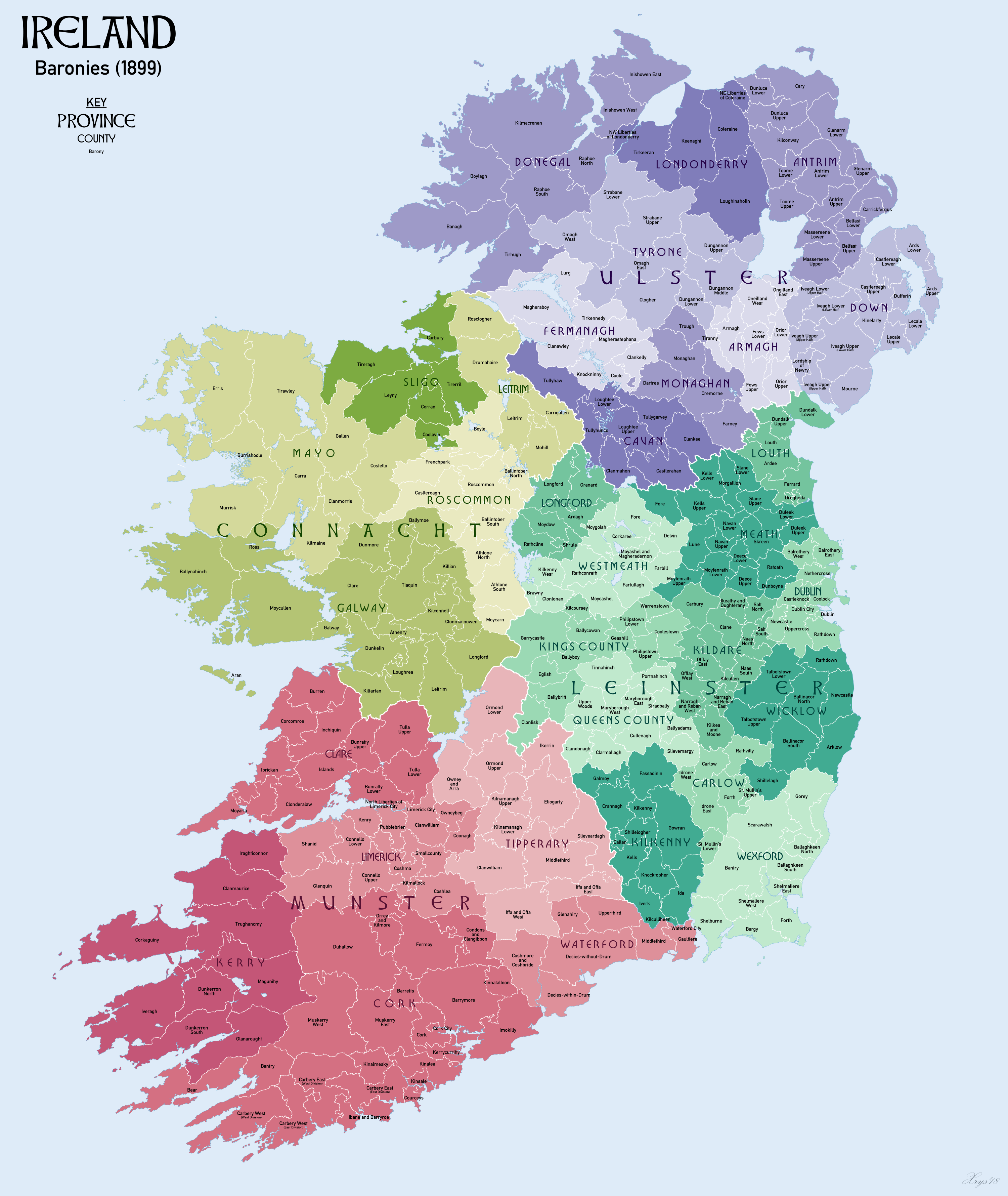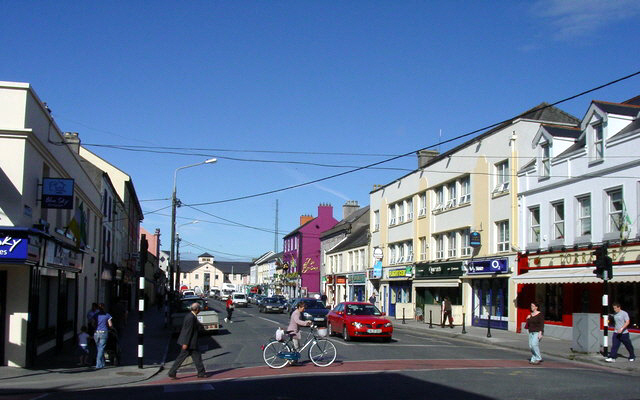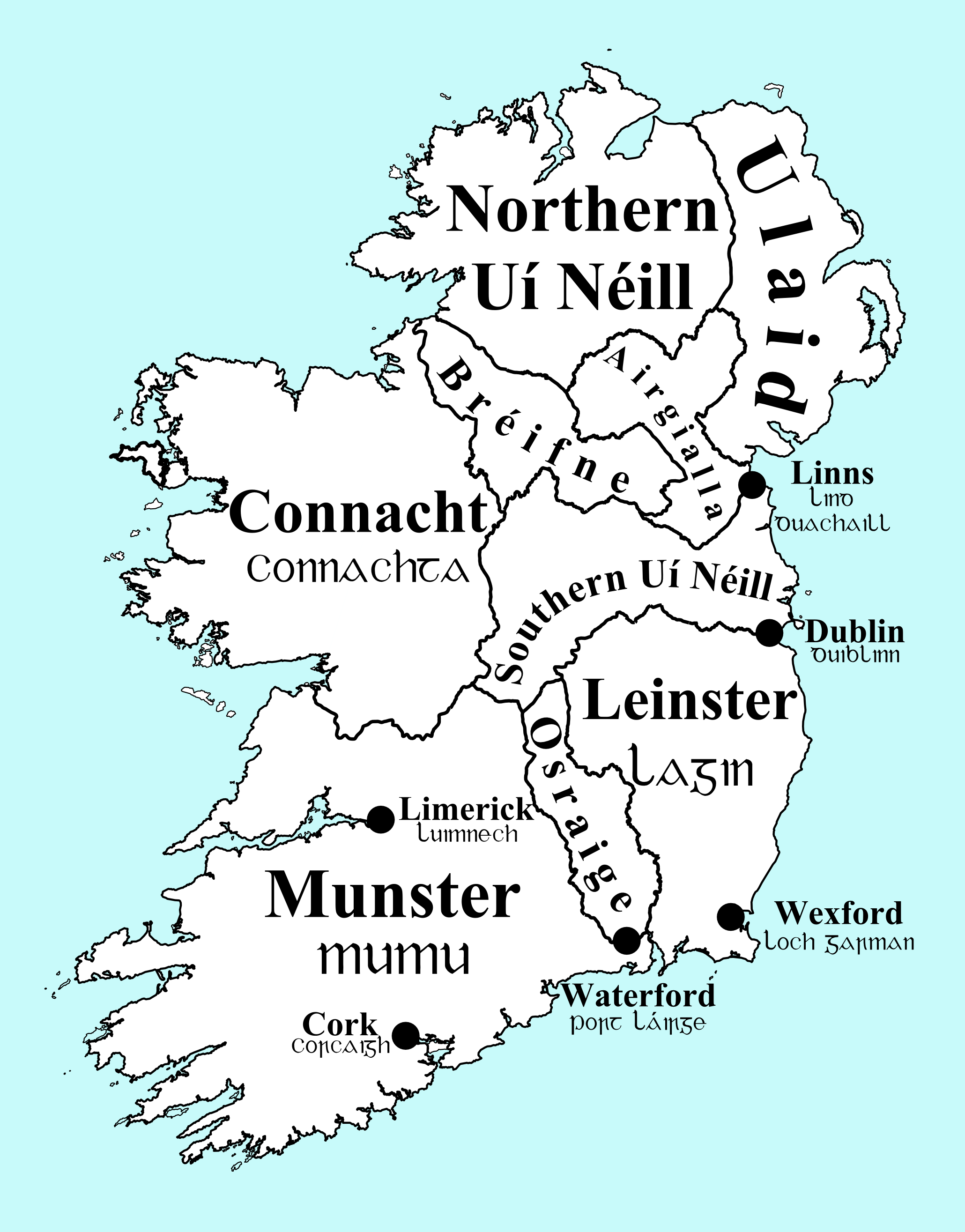|
Ballycowan (barony)
Ballycowan or Ballycowen () is a barony in County Offaly (formerly King's County), Republic of Ireland. Etymology Ballycowan derives its name from Ballycowan Castle (near Tullamore) and the townland of Ballycowan (Irish ''Baile Mhic Comhainn'', "settlement of Mac Comhainn"). Location Ballycowan is located in north County Offaly, around the valleys of the Clodiagh River and Silver River. History Ballycowan was part of the territory of the Ó Maolmhuaidh (O'Molloy) sept of the Southern Uí Néill The Southern Uí Néill ( ga, Uí Néill an Deiscirt, IPA: �iːˈnʲeːl̪ʲˈanˠˈdʲɛʃcəɾˠtʲ were that branch of the Uí Néill dynasty that invaded and settled in the Kingdom of Mide and its associated kingdoms. In the initial decades t .... The Uí Shuanaig (Fox?) sept is cited here near Rathan. List of settlements Below is a list of settlements in Ballycowan: * Durrow * Rahan * Screggan * Tullamore References Baronies of County Offaly {{Offaly-geo-stub ... [...More Info...] [...Related Items...] OR: [Wikipedia] [Google] [Baidu] |
Irish Language
Irish (an Caighdeán Oifigiúil, Standard Irish: ), also known as Gaelic, is a Goidelic languages, Goidelic language of the Insular Celtic branch of the Celtic language family, which is a part of the Indo-European languages, Indo-European language family. Irish is indigenous language, indigenous to the Ireland, island of Ireland and was the population's first language until the 19th century, when English (language), English gradually became Linguistic imperialism, dominant, particularly in the last decades of the century. Irish is still spoken as a first language in a small number of areas of certain counties such as County Cork, Cork, County Donegal, Donegal, County Galway, Galway, and County Kerry, Kerry, as well as smaller areas of counties County Mayo, Mayo, County Meath, Meath, and County Waterford, Waterford. It is also spoken by a larger group of habitual but non-traditional speakers, mostly in urban areas where the majority are second language, second-language speakers. ... [...More Info...] [...Related Items...] OR: [Wikipedia] [Google] [Baidu] |
Barony (Ireland)
In Ireland, a barony ( ga, barúntacht, plural ) is a historical subdivision of a county, analogous to the hundreds into which the counties of England were divided. Baronies were created during the Tudor reconquest of Ireland, replacing the earlier cantreds formed after the original Norman invasion.Mac Cotter 2005, pp.327–330 Some early baronies were later subdivided into half baronies with the same standing as full baronies. Baronies were mainly cadastral rather than administrative units. They acquired modest local taxation and spending functions in the 19th century before being superseded by the Local Government (Ireland) Act 1898. Subsequent adjustments of county boundaries mean that some baronies now straddle two counties. The final catalogue of baronies numbered 331, with an average area of ; therefore, each county was divided, on average, into 10 or 11 baronies. Creation The island of Ireland was "shired" into counties in two distinct periods: the east and sou ... [...More Info...] [...Related Items...] OR: [Wikipedia] [Google] [Baidu] |
List Of Sovereign States
The following is a list providing an overview of sovereign states around the world with information on their status and recognition of their sovereignty. The 206 listed states can be divided into three categories based on membership within the United Nations System: 193 member states of the United Nations, UN member states, 2 United Nations General Assembly observers#Present non-member observers, UN General Assembly non-member observer states, and 11 other states. The ''sovereignty dispute'' column indicates states having undisputed sovereignty (188 states, of which there are 187 UN member states and 1 UN General Assembly non-member observer state), states having disputed sovereignty (16 states, of which there are 6 UN member states, 1 UN General Assembly non-member observer state, and 9 de facto states), and states having a political status of the Cook Islands and Niue, special political status (2 states, both in associated state, free association with New Zealand). Compi ... [...More Info...] [...Related Items...] OR: [Wikipedia] [Google] [Baidu] |
Republic Of Ireland
Ireland ( ga, Éire ), also known as the Republic of Ireland (), is a country in north-western Europe consisting of 26 of the 32 Counties of Ireland, counties of the island of Ireland. The capital and largest city is Dublin, on the eastern side of the island. Around 2.1 million of the country's population of 5.13 million people resides in the Greater Dublin Area. The sovereign state shares its only land border with Northern Ireland, which is Countries of the United Kingdom, part of the United Kingdom. It is otherwise surrounded by the Atlantic Ocean, with the Celtic Sea to the south, St George's Channel to the south-east, and the Irish Sea to the east. It is a Unitary state, unitary, parliamentary republic. The legislature, the , consists of a lower house, ; an upper house, ; and an elected President of Ireland, President () who serves as the largely ceremonial head of state, but with some important powers and duties. The head of government is the (Prime Minister, liter ... [...More Info...] [...Related Items...] OR: [Wikipedia] [Google] [Baidu] |
Counties Of Ireland
The counties of Ireland ( Irish: ) are historic administrative divisions of the island into thirty-two units. They began as Norman structures, and as the powers exercised by the Cambro-Norman barons and the Old English nobility waned over time, new offices of political control came to be established at a county level. Upon the partition of Ireland in 1921, six of the traditional counties became part of Northern Ireland. In Northern Ireland, counties ceased to be longer used for local government in 1973; districts are instead used. In the Republic of Ireland, some counties have been split resulting in the creation of new counties: there are currently 26 counties, 3 cities and 2 cities and counties that demarcate areas of local government in the Republic. Terminology The word "county" has come to be used in different senses for different purposes. In common usage, it can mean the 32 counties that existed prior to 1838 – the so-called traditional counties, 26 of which are ... [...More Info...] [...Related Items...] OR: [Wikipedia] [Google] [Baidu] |
County Offaly
County Offaly (; ga, Contae Uíbh Fhailí) is a county in Ireland. It is part of the Eastern and Midland Region and the province of Leinster. It is named after the ancient Kingdom of Uí Failghe. It was formerly known as King's County, in honour of Philip II of Spain. Offaly County Council is the local authority for the county. The county population was 82,668 at the 2022 census. Central Statistics Office figures Geography and political subdivisions Offaly is the 18th largest of Ireland's 32 counties by area and the 24th largest in terms of population. It is the fifth largest of Leinster's 12 counties by size and the 10th largest by population.Physical geography [...More Info...] [...Related Items...] OR: [Wikipedia] [Google] [Baidu] |
Tullamore
Tullamore (; ) is the county town of County Offaly in Ireland. It is on the Grand Canal, in the middle of the county, and is the fourth most populous town in the midlands region with 14,607 inhabitants at the 2016 census. The town retained Gold Medal status in the National Tidy Town Awards in 2015 and also played host to the World Sheep Dog Trials in 2005 which attracted international interest in the region. The Tullamore Show is held near the town every year. The town's most famous export is Tullamore Dew – an Irish whiskey distilled by Tullamore Distillery – that can be traced back to 1829. The original distillery was shut down in 1954, with the brand later being resurrected and produced at the Midleton Distillery, in Cork. However, the brand's new owners, William Grant & Sons, invested in a new distillery near Tullamore, bringing whiskey production back to the town in 2014. History In the Middle Ages, Tullamore was within the Gaelic territory of Firce ... [...More Info...] [...Related Items...] OR: [Wikipedia] [Google] [Baidu] |
Clodiagh River
The River Clodiagh () is a small river which rises in Lough Coumduala in the Comeragh Mountains in north County Waterford. (''It should not be confused with the River Clodiagh in County Kilkenny.'') It flows through the villages of Rathgormack, Clonea-Power and Portlaw before joining the River Suir just outside Portlaw. The river is fed by a number of smaller tributaries including Hunts stream and Aughtnawilliam stream. Kayak tragedy Two canoeists, one a sit-on kayak A kayak is a small, narrow watercraft which is typically propelled by means of a double-bladed paddle. The word kayak originates from the Greenlandic word ''qajaq'' (). The traditional kayak has a covered deck and one or more cockpits, each se ..., drowned after being stuck in a weir at Portlaw, in April 2010. References External links * Clodiagh {{Ireland-river-stub ... [...More Info...] [...Related Items...] OR: [Wikipedia] [Google] [Baidu] |
Silver River (Ireland)
The Silver River () flows from the Slieve Bloom Mountains in the south of County Offaly in central Ireland. The village of Cadamstown, on the river, is the home of The Silver River Geological Reserve. Course The Silver rises on the northwestern slopes of Baureigh Mountain (486 m) and descends to Cadamstown, the first settlement it encounters. Flowing westwards it passes Ballyboy and Kilcormac before turning north to join the River Brosna near Ferbane. The Brosna flows west from the confluence to join the River Shannon The River Shannon ( ga, Abhainn na Sionainne, ', '), at in length, is the longest river in the British Isles. It drains the Shannon River Basin, which has an area of , – approximately one fifth of the area of the island of Ireland. The Sha ... at Shannon Harbour. The Silver River is contained mostly within County Offaly but flows briefly within County Westmeath. Rivers of County Offaly {{Ireland-river-stub ... [...More Info...] [...Related Items...] OR: [Wikipedia] [Google] [Baidu] |
Ó Maolmhuaidh
''Maolmhuaidh'' is an Irish surname, generally anglicised as ''Molloy'' or ''Mulloy''. Like other Irish surnames, ''Maolmhuaidh'' is patronymic. The male version is ''Ó Maolmhuaidh'' ("ó" meaning "son of"); the female versions are ''Uí Mhaolmhuaidh'' ("uí" meaning "wife of") and ''Ní Mhaolmhuaidh'' ("ní" meaning "daughter of"); the family or house name is ''Uí Mhaolmhuaidh''. Ó Maolmhuaidh Fir Cell The Uí Maolmhuaidh of Fir Cell (''men of the churches'', in what is now County Offaly) claimed descent from the southern Uí Néill. The 16th-century mercenary, Captain Greene O'Mulloy, was of this family. Ó Maoil Aodha Oirthir Connachta The Uí Maoil Aodha ("descendant of the devotee of (St.) Aodh") family lived in east Connacht, and is now found as both Mullee and Molloy. Ó Maolmhaodhóg Tir Connall The Uí Maolmhaodhóg ("descendant of the devotee of (St.) Maodhóg") surname is now usually rendered as Mulvogue, or Logue, but sometimes Molloy, particularly around the Gle ... [...More Info...] [...Related Items...] OR: [Wikipedia] [Google] [Baidu] |
Southern Uí Néill
The Southern Uí Néill ( ga, Uí Néill an Deiscirt, IPA: �iːˈnʲeːl̪ʲˈanˠˈdʲɛʃcəɾˠtʲ were that branch of the Uí Néill dynasty that invaded and settled in the Kingdom of Mide and its associated kingdoms. In the initial decades two sons of Niall Noigiallach, Lóegaire and Coirpre and their immediate descendants led the dynasty. However, after the murder of Túathal Máelgarb in about 549, it was left to another branch of the family descended from another of Niall's sons – Conall Cremthainne – to continue Uí Néill expansion and consolidate their position. No descendants of either Lugaid mac Lóegairi or Túathal Máelgarb are recorded, and it is not unlikely that they were either erased from the genealogical record, or indeed literally erased from history. Just as their kinsmen the Northern Uí Néill split into two main branches, so too did the Southern Uí Néill, both being descended from sons of Diarmait mac Cerbaill, Colmán Már and Áed Sláine. T ... [...More Info...] [...Related Items...] OR: [Wikipedia] [Google] [Baidu] |
Durrow, County Offaly
Durrow () is a small rural village and townland in County Offaly, Ireland. Durrow is located on the N52 off the N6 road between Kilbeggan (in County Westmeath) and Tullamore (in County Offaly). Durrow Abbey, surrounded by woods, is one of Ireland's most important early Christian monasteries founded by Saint Colmcille. Some mistakenly assign County Laois as the location of this particular monastic settlement due to the presence of a larger town in Laois called Durrow. Monastery Iona was established in exile and during that time Colum Cille yearned for monasteries in Ireland. The poem 'An Exile's Dream' specifically indicates Durrow as location for a monastery. Durrow was then part of the territory of Tethba, which now lies mostly in Co. Longford. It was also located near one of Ireland's five ancient routes, Slighe Mór. However, no accounts survive of what Colum Cille's monastery was like at its foundation. The monastic enclosure of Durrow can be seen in the aerial photo ... [...More Info...] [...Related Items...] OR: [Wikipedia] [Google] [Baidu] |





